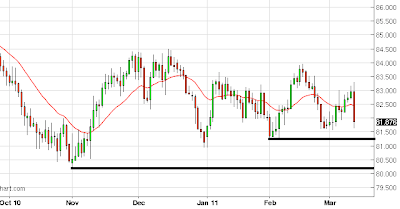Last week saw the biggest weekly gain in the US stock market for 2 months despite geopolitical uncertainty in the Middle East. Crude oil continued to increase as unrest spread to Yemen and Syria. Gold reached a new all-time high at 1447.5 but quickly pulled back in to its recent range. Let’s have a look at some of the developments happening this week.
Investor focus could be spread over a few factors this week as the debt levels of peripheral Eurozone countries come to the fore once again, ongoing tension in the Middle East, a nuclear reactor in Japan yet to be fully safeguarded and the latest employment data from the US all jostle for the headlines. These developments are likely to have a large impact on the euro, crude oil, stock markets and stock markets respectively.
Economic Releases
There will be relatively few economic releases for investors again this week but there are some high impact releases:
- 9.30 Tuesday, UK GDP (final). And a host of other economic numbers will be released for the UK which is likely to cause some volatility in the pound.
- 1:30 Friday, Non-farm Payrolls. The super bowl of economic releases on the first Friday of every month. Expect volatility in the US dollar and stocks. Some good figures are expected for this week which should show lots of jobs have been created in the world’s largest economy. After such a good week in equities last week, this could be another good week in anticipation of this event.
Currency Focus
Euro: the euro performed well last week and reached a high of 1.4248 against the US dollar. The euro has been torn lately rallying on speculation the ECB will raise interest rates in April but falling on concern that Portugal and the 4th largest economy of the Eurozone Spain are struggling to treat their debt. The euro could pull back this week to test support around 1.3880 as the latter comes into focus. If the ECB decides not to raise interest rates in April this could also lead to a big sell off for the euro.
Aussie Dollar: the Aussie dollar had a great week last week and finished strongly against most currencies especially the US dollar. The Aussie dollar has benefitted recently due to the surge in commodity prices and the close proximity of Australia to China which has huge demand for raw materials. A much larger gain in the Aussie dollar will certainly curb demand for it’s exports and pull backs are expected at these high levels.
Watch List
 |
| AUD/USD Daily Chart |
AUD/USD: Overbought on the daily chart and at historically high levels. I will be looking for a daily reversal set-up or for announcements which may effect the Aussie dollar badly such as reports of a slowdown in China to enter this pair short back down to the moving average or to the magnetic 1.0000 level.
Crude Oil: I am continuing to watch the price of crude oil closely and developments in Saudi Arabia are pivotal. Syria and Yemen are minor exporters of oil but any significant threat to oil supply from Saudi Arabia could send crude oil through the roof. Whilst this remains fairly unlikely it is still a distinct possibility.
Thanks for reading this weeks “The Week Ahead”.




